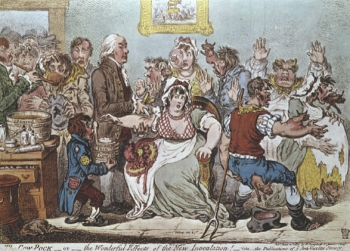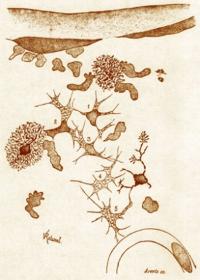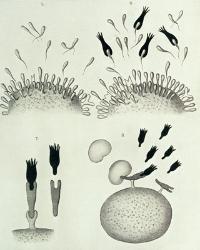Allergy and Immunity - Early Milestones
 In 1798, the English country practitioner Edward Jenner showed that inoculation with cowpox could protect against subsequent exposure to smallpox. This became the first reliable method of giving lasting immunity against a major contagious disease. Jenner’s famous studies began a pathway of discovery of the immune system, how it works and how it can be used for the benefit of Man. Many Nobel Prizes have been awarded to scientists who have contributed to this story.
In 1798, the English country practitioner Edward Jenner showed that inoculation with cowpox could protect against subsequent exposure to smallpox. This became the first reliable method of giving lasting immunity against a major contagious disease. Jenner’s famous studies began a pathway of discovery of the immune system, how it works and how it can be used for the benefit of Man. Many Nobel Prizes have been awarded to scientists who have contributed to this story.
Image right: Cartoon by James Gillray satirising Jenner, 1802 (private collection)
A hundred years after Jenner’s pioneering work, battle was raging on the question of whether immunity to infection could best be explained by cellular or humoral mechanisms. In the 1880s, the Russian Elie Metchnikoff had been intrigued by mobile cells in starfish larvae, which he observed surrounding and eventually disposing of rose thorns introduced into the larvae. Further studies on macrophages and the process that he called phagocytosis led to his concept of cellular immunity as the main defence against infection.
The humoral concept of immunity was initiated in Germany by the work of Emil von Behring in 1890 on diphtheria and tetanus antitoxins. Paul Ehrlich’s work on the standardisation of diphtheria antitoxin completed the foundation of serotherapy. Proponents of the humoral theory claimed that only soluble substances of the blood and other body fluids could immobilise and destroy invading pathogens. Ehrlich went on to propose his famous ‘side chain theory’ whereby each cell made surface receptors which could bind to foreign antigens by a highly specific ‘lock and key’ fit – the forerunner of antibodies.

Image left: Metchnikoff's drawing of phagocytes at a site of inflammation (caused by the application of silver nitrate) in the caudal fin of a Triton embryo (Nature)
In 1901, Charles Richet and Paul Portier from France demonstrated that immune reactions could be harmful rather than protective. They had been invited by Prince Albert of Monaco while cruising on his yacht to study the jellyfish Physalia (Portuguese Man o’ War), and hoped to develop a protective antiserum for bathers and divers. On their return to France they studied sea anemones (having run out of jellyfish) and found that attempts to immunise dogs against the toxins in the anemone tentacles induced a state of hypersensitivity, which they termed 'anaphylaxis' (literally ‘against protection’).
 In 1906, the Austrian Clemens von Pirquet coined the term 'allergy' (from the Greek ‘alol’ meaning change in original state). He found that some patients treated with anti-serum developed a spectrum of local and systemic symptoms, which he termed ‘serum sickness’. Serotherapy therefore seemed to be able to produce both immunity and hypersensitivity. His concept of ‘changed reactivity’ was to lay the foundation for the modern science of immunology by appreciating that a foreign substance ‘sensitises’ in a way that produces a different response on second and subsequent administration.
In 1906, the Austrian Clemens von Pirquet coined the term 'allergy' (from the Greek ‘alol’ meaning change in original state). He found that some patients treated with anti-serum developed a spectrum of local and systemic symptoms, which he termed ‘serum sickness’. Serotherapy therefore seemed to be able to produce both immunity and hypersensitivity. His concept of ‘changed reactivity’ was to lay the foundation for the modern science of immunology by appreciating that a foreign substance ‘sensitises’ in a way that produces a different response on second and subsequent administration.
Image right: Diagram illustrating Paul Ehrlich's side-chain theory, 1900 (Wellcome Library)